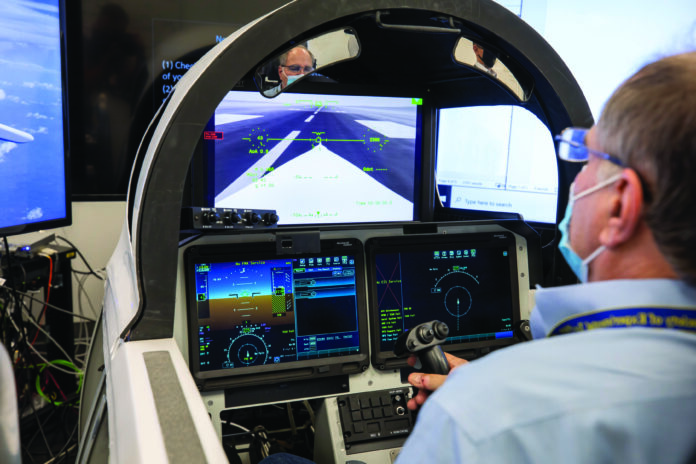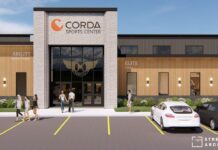
For nearly a century, Collins Aerospace – and its corporate predecessors – has been inexorably tied to Cedar Rapids, and the aerospace and defense company has stood as the city’s largest employer for decades, establishing a reputation for quality and leading-edge technology along the way. According to an online company history, Collins Radio Company, founded […]
Want to Read More?
Get immediate, unlimited access to all subscriber content and much more.
Learn more in our subscriber FAQ.
- Unparalleled business coverage of the Iowa City / Cedar Rapids corridor.
- Immediate access to subscriber-only content on our website.
- 26 issues per year delivered digitally, in print or both.
- Support locally owned and operated journalism.
Do you want to read and share this article without a paywall?
Click here to purchase a paywall bypass linkFor nearly a century, Collins Aerospace – and its corporate predecessors – has been inexorably tied to Cedar Rapids, and the aerospace and defense company has stood as the city’s largest employer for decades, establishing a reputation for quality and leading-edge technology along the way.
According to an online company history, Collins Radio Company, founded by Arthur Collins in Cedar Rapids in 1933, initially designed and produced short wave radio equipment. The company steadily grew, and captured the world's attention when Collins supplied the equipment to establish a communications link with the South Pole expedition of Rear Admiral Richard Byrd in 1933.
During the next three decades, Collins continued to expand its work in all phases of the communications field while broadening its technology thrust into numerous other disciplines. New developments such as flight control instruments, radio communication devices and satellite voice transmissions created new opportunities in the marketplace.
Collins Radio Company provided communications in America's space program, including equipment for astronauts to communicate with earth stations and equipment to track and communicate with spacecraft. Collins communications equipment was used for the Apollo, Gemini and Mercury programs, providing voice communication for every American astronaut traveling through space. In 1973, the U.S. Skylab program used Collins equipment to provide communication from the astronauts to earth. Collins also gained international notoriety for supplying equipment for the space shuttle program.
When Collins Radio experienced financial difficulties, Rockwell International, a diversified high-technology company, acquired the company in 1973. The company further strengthened the focus on aviation electronics in May 1998 when Rockwell Collins exited the Precision Agriculture and Integrated Local Government business and sold its Railroad Electronics business to Westinghouse Air Brake Company.
On June 29, 2001, Rockwell Collins, Inc. was spun off from Rockwell International and began trading its shares on the New York Stock Exchange under the symbol "COL."
United Technologies (UTC) completed a $30 billion acquisition of Rockwell Collins in late 2018.
Then in April 2020, UTC and Raytheon merged, forming one of the world’s largest aerospace and defense companies in a $135 billion deal. As a result of that deal, Raytheon became the parent company of Collins Aerospace, including its operations in Cedar Rapids.
The parent company, now known as RTX, encompasses three operating subsidiaries – Collins Aerospace, Raytheon and Pratt & Whitney.
Today, Collins-brand aircraft electronics are installed in the cockpits of nearly every airline in the world, and its communication systems transmit nearly 70% of U.S. and allied military airborne communications.
The CBJ posed a series of questions to Collins Aerospace leaders regarding the company’s past, present and future operations, including potential opportunities for growth. Those questions and answers appear below.
Q: If you had to boil down Collins Aerospace’s mission to an elevator pitch, how would you describe the company in its current iteration?
A: In shortest form, Collins Aerospace and RTX work to solve the hardest problems in aerospace and defense. To put that in perspective:
- Every second of every day, an aircraft carrying Collins Aerospace technology takes flight.
- 1 billion gallons of fuel have been saved by our increasingly efficient aircraft engines.
- 11 million air travel passengers are supported every day by our aviation systems.
- And 70% of the airborne communications for the U.S. and allied nations are supported by our technology.
Q: In a broad sense, there are two chief business units within Collins Aerospace: commercial aviation and military systems and equipment. What are the basic business units in Cedar Rapids? What are the largest of those units, and approximately how many people are employed in each unit?
A: Today, Collins has nearly 9,000 employees across the state, with two of our primary business units based in Cedar Rapids (Mission Systems and Avionics). Collins has a substantial presence in Eastern Iowa, but the company is also in Decorah, where we added 6,500 square feet to our manufacturing footprint in the past two years, and West Des Moines, home to a $14 million additive manufacturing center expansion.
Mission Systems is comprised of several portfolios ranging from Assured PNT, military communications, space systems and tactical data links, and houses RTX’s Connected Battlespace portfolio, enabling multi-domain operations.
Avionics provides reliable communications, navigation, display and multisystem management avionics technology for defense and commercial use.
Collins has six business units: Advanced Structures, Avionics, Connected Aviation Solutions, Interiors, Mission Systems, and Power & Controls.
Q: How many individual properties does Collins Aerospace own or utilize in Cedar Rapids and throughout Iowa, and how much square footage does each facility occupy? Does the company own all its buildings? Is any space subleased to other companies? Is the company planning to retain all its current Cedar Rapids properties for the foreseeable future, even those formerly occupied by BAE Systems?
A: Collins has seven locations across Iowa, with nearly 9,000 employees across the state: Cedar Rapids, Bellevue, Coralville, Decorah, Manchester, West Des Moines and Carroll. Cedar Rapids is headquarters for Avionics and Mission Systems businesses. Collins is Iowa’s #1 technology company, employing nearly 4,000 engineers, scientists and IT workers. The company’s annual economic impact is $3.2 billion, both direct and indirect. The annual philanthropic support is nearly $3 million, including company and employee contributions.
The company’s Iowa supply chain includes 450 suppliers and a $223 million spend.
Q: How many authorized positions are there at each Collins Aerospace location in Iowa, and how many are currently employed at each location? How has that changed in recent years, with periodic workforce layoffs and expansions? Are there plans to bring more employees to Iowa?
A: Iowa is a key location for Collins Aerospace, with 9,000 employees across the state and more than $3 billion of annual economic impact. We’ve been delivering key technology solutions for our customers here for decades, and our operations have evolved and grown during this time.
Q: How many people work remotely for Collins Aerospace in Iowa, and does that impact how many properties the company will retain in the future? How many employees worked remotely during the pandemic, and approximately how many of them have returned in-person, versus those who continue to work remotely? How will the number of remote employees change in the future?
A: Collins Aerospace has onsite, hybrid, and remote roles. This role type structure is an important element of our workforce diversity and talent strategy. As always, we will balance our role type structure with meeting the needs of our business and executing on customer commitments. That means the criteria for role types can change as job requirements and business needs evolve.
Q: The former Rockwell Collins was acquired by Raytheon via a merger between Raytheon and United Technologies. The company is now known as RTX. How has the new affiliation impacted Collins Aerospace? Have new markets been opened? Is the company operated differently (more efficiently, for example) than prior to the merger?
A: RTX realigned its businesses, streamlining from four to three focused business segments – Collins Aerospace, Pratt & Whitney and Raytheon. We did this to:
- Improve our performance;
- Further align our market-leading franchises with our customers’ priorities;
- Enhance cross-company collaboration to expand competitive positioning;
- Realize additional product, technology and revenue synergies; and
- Leverage scale to optimize our operations, footprint and cost structure.
The goal has always been to make this realignment a seamless transition for our customers and the company’s focus has not wavered post-realignment.
Q: What functions were combined into Collins Aerospace as part of the realignment, and how has that consolidation impacted the company’s operations in Cedar Rapids and throughout Iowa?
A: As part of the realignment, nearly $2.7 billion in business was transitioned to Collins Aerospace, including 4,700 positions – though not all in Iowa. The company absorbed business from Raytheon’s Intelligence & Space and Missiles and Defense divisions work supporting autonomous systems, command and control, networking and connectivity, protected communications and battle management. The move is intended to leverage Collins’ commercial and military expertise to help support the DoD’s JADC2 strategy.
Q: Since its founding as Collins Radio, Collins Aerospace has experienced multiple transitions – most recently UTC purchasing Rockwell Collins in 2018, then the creation of Raytheon Technologies in April 2020 through the merger of Raytheon and United Technologies. As part of those transitions, and as Collins Aerospace’s headquarters has been moved, the broader community has often expressed concern about the company’s long-term commitment to Cedar Rapids and Eastern Iowa. How would you speak to that commitment? The fates of Collins and Cedar Rapids have been inexorably intertwined for several decades. What does Raytheon plan to do to solidify those legacies for future generations? Are there any plans to move any existing divisions or units to other locations in the Collins Aerospace ecosystem?
A: We’ve been in Iowa for 90 years, and it’s a key location for Collins Aerospace – we're proudly one of the largest local employers and contribute to more than $3 billion of economic impact annually. Collins Aerospace regularly reviews its business portfolios to ensure the company is well-positioned to meet customer requirements and drive long-term growth. The divestiture of the Collins Aerospace Actuation Systems business will optimize resources and position Collins for future success as a business of the world’s largest aerospace and defense company.
Q: Collins Aerospace’s child care facility is expansive and seems to grow each year. Why is the company so committed to facilities like this? How many staff and students are affiliated with the child care center? There’s also a large fitness center on the Collins Aerospace main campus. What is provided at that facility? How does that work for employees, and are there other employee-focused facilities on the Collins property you’d like to mention?
A: Collins Aerospace offers competitive compensation and total benefits packages to our employees including health and wellness plans, retirement savings, work and life support and tuition assistance.
Q: Based on the business functions outlined above, what does RTX see as its biggest potential growth opportunities, and how do those opportunities align with Collins Aerospace’s core functions? Are you expecting an upswing in demand in either the military or commercial equipment markets?
A: RTX realigned to optimize our core capabilities, better align with our customer priorities and more effectively leverage our scale to be more responsive. Collins is committed to the company’s customer set – both commercial and defense – and will continue to deliver on our commitments and seek growth opportunities. This realignment allows the company to bring our mix of commercial and defense portfolios together in new and proven ways, providing us the ability to leverage commercial business models for defense applications and priming the ability to move from concept to delivery faster.
Q: What are the emerging technologies and systems that will be key to RTX’s, and Collins Aerospace’s, future success? What threats lurk on the horizon that could impede those plans?
A: Collins Aerospace’s legacy of connectivity, command and control, and commercial and defense offerings continue to inform the company’s direction moving forward. The realignment supports improved workflow between businesses and the company will continue to work to solve customers’ toughest challenges.
Q: How, if at all, will Collins Aerospace operations in Iowa be modified in upcoming years to meet the new challenges of an ever-evolving industry? How does Collins plan to rise above its competitors and continue to grow? Are there any plans to diversify the company’s operations, including any new partnerships or product lines?
A: Collins is developing the most impactful strategies in aerospace to evolve with the industry’s challenges. We have a unique perspective within the business and across RTX, and we’re using the breadth of our technologies to redefine aerospace for customers, passengers and to create a more sustainable future.




